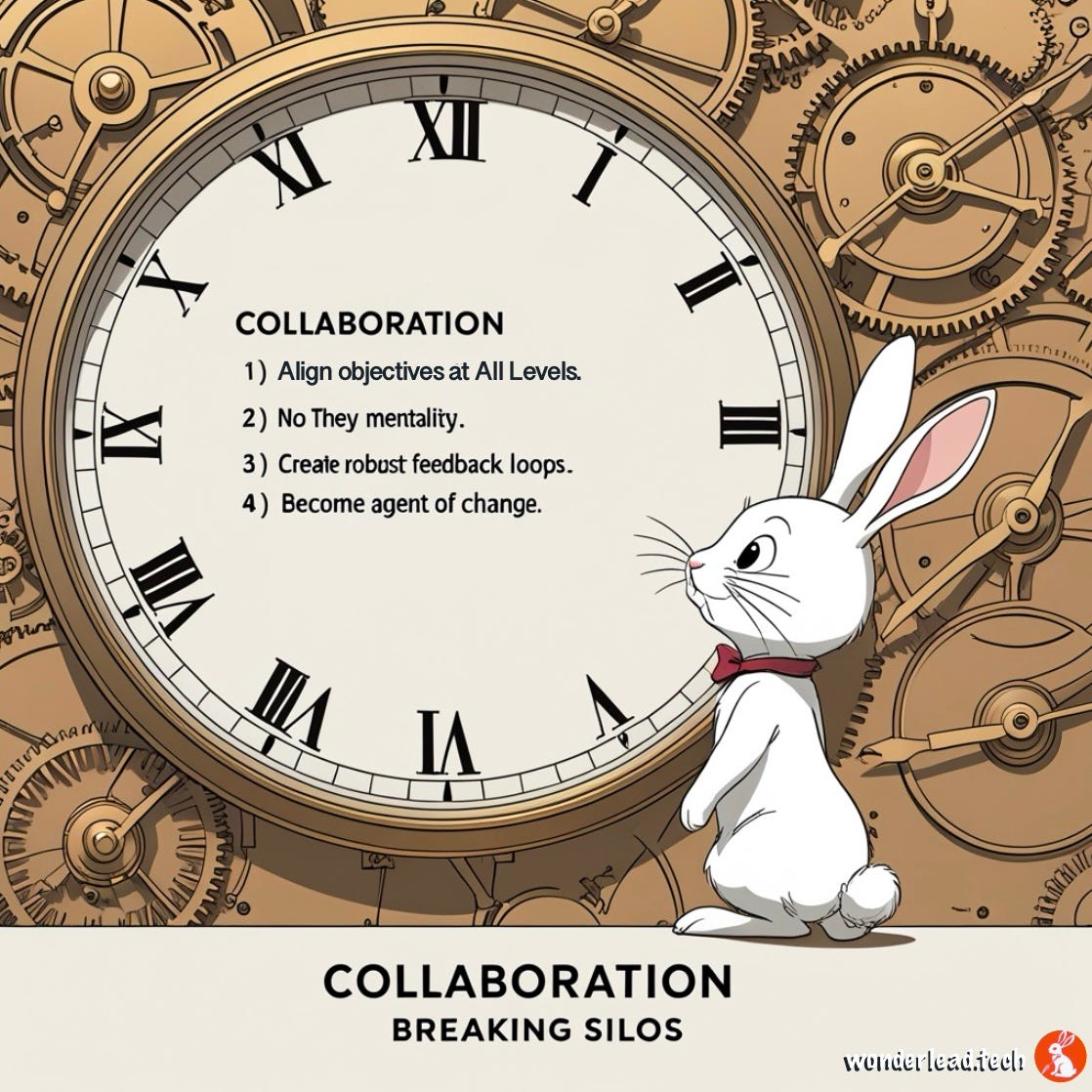Breaking Down Silos in Tech
4 Practical Tips to Foster Collaboration as a Leader
What You'll Learn:
💡 How to identify and break down common collaboration barriers
💡 Practical strategies for fostering cross-team communication
💡 Steps to become an agent of positive change
In today's fast-paced, ever-evolving IT business, the ability to collaborate effectively has become a critical skill for leaders.
Recently, in my team at AWS, leadership suddenly changed our vision, and multiple projects that were in progress had to stop overnight. The uncertainty and unexpected change impacted the motivation of almost everyone in all the teams. However, what could have been a crisis became an opportunity for growth. Our leadership suggested doing multiple hack weeks while reshuffling the roadmap and increasing 1:1s to rebuild trust. The collaboration fostered by the hack weeks raised motivation, innovation, and performance. Within a few weeks, people started to smile back.
Benefits on Collaboration in Leadership
Thriving leaders cultivate an environment of mutual understanding, psychological safety, and a shared sense of purpose and empower their people to collaborate together.
Open collaboration creates space for exploration, diverse perspectives, and creative risk-taking. It brings the best decision-making, problem-solving, conflict resolution, innovation, motivation, performance, and stronger relationships.
Hi 🙋🏻♀️! Today, Artur is sharing how to break down silos to raise collaboration.
Artur, over to you!
Thank you Patricia, hello everybody! I am
The Collaboration Barriers & How to Break Them
1. Misaligned Objectives
During the first months of any year, the company’s objectives are communicated top-down with a high-level strategy full of buzzwords to achieve them. Projects are allocated, and the staff’s year objectives are cascaded down, losing granularity and real meaning by the time they reach the IT engineer. At the higher level, the outcomes of the projects are translated by fulfilling or delivering a specific well-identifiable set of objectives.
However, the reality sometimes looks like a stand-up comedy sketch. Imagine being in a meeting and being instructed to find ways to be more cost-efficient for an entire IT department. In practice, this means we need to decrease the budget somewhere while maintaining the same output, or we need to find ways to reduce headcount without impacting key projects. While in the same meeting, I was told to onboard a new project related to infrastructure migration, whose outcome will increase the run costs by 20-30%. To make everything even more wonderful, this needs to happen without assigning specific investment budget lines for each application (aimed at hiding the true cost of the investment by diluting it across the same cost centers as day-to-day activities). Situations like these are a bad joke but, unfortunately, occur openly in any large organization.
This is due to feedback not being passed through higher management and not being aware of how some details are dealt with, also the fact higher management is a difficult silo to reach a lot of times. However, these silos can have multiple forms. One of the most popular is having the sales team closing contracts with clients based on features that product teams are not even aware of. Let alone the IT department have started development on those features.
How to address this?
It starts from the top!
Cascading objectives is not a straightforward operation. In the same way the C-Level management defines objectives for the coming years, (1) these objectives need to be aligned with each department in the organization, and (2) the plan needs to be coherent between the strategy and objectives.
Based on the example given above, if the directive is to reduce costs for the IT department, how will the approved projects contribute to the different kinds of objectives? How to tackle a project whose outcome will make some problems even worse for a specific period?
2. Us / They Mentality
Not all problems are to be fixed by the C-Level management. Some of the Silo mentality happens at the very base: The Us & They kind of conversation. Sometimes the “They” are the team seated nearby at the office, and barely there is any communication between them. And when a communication happens, it is typically to make some last-minute request due to an unforeseen dependency.
Once I worked in an office where some Team Leaders were openly forbidding interaction with colleagues from other teams. Like they were professors teaching kids from kindergarten to avoid those bad boys from the hood impacting their day. A way these enlightened leadership folk found to control communication, was by assigning Single Points of Contact (SPOC) that became bottlenecks for everything important.
These kinds of leadership will result in weak teams and fragile workflows. True Leaders should avoid the “Us/They” language at all costs.
How to address this?
Cultivate synergies between dependent teams. The easiest way to cultivate synergies is to organize a workshop for people to present themselves (Boring, I know! I did this almost 10 times in a week once).
In the teams presentation workshop, start by breaking the ice and letting people organically talk with each other, with the clear goal of letting information flow and cultivating collaboration in the form of help, technical insights, and allowing learned experiences to be shared among peers.
3. Insufficient Feedback Loops
Once I was tasked to define a set of tools to be used for the Project Management Office (PMO) scope of the company. I was “invited” to a demo of a Project Management tool that is very popular in the internet realm. However, my testing showed the tool was missing some key features someone would expect from a Project Management software, like automatic scheduling based on task durations and ways to understand if a team member was over-allocated on projects or tasks (basic resource management).
During the meeting, the salesperson was having difficulties understanding my feedback and complaints about the tool. I was trying so hard to hide my surprise (moreover, shock), since the features I was referencing are standard for Microsoft Project or even Open-Source Project Management software.
Once the meeting was over, I didn’t believe the tool didn’t have the most basic features, so I went to Mr. Google and figure this one out for myself. The vendor has a very interesting community forum to which I was granted access. While I investigated the forum further, I couldn’t believe what I found and I was even more shocked. It was clear they were having multiple people giving the same feedback as I and their support engineers were having the same challenges understanding the problem. Nobody at that entire company had a look at Microsoft Project and its basic features. No benchmarking study, no feedback loops between Support, Sales, and Product Teams, nothing! Each department is a silo.
How to address this?
Organize workshops to share feedback about pain points and common complaints between different departments.
⋆。°✩ Become an Agent of Change ✩°。⋆
Breaking these silos is a responsibility of each of us. The most important aspect of breaking a silo is for every one of us to become what I call an “Agent of Change”. It starts by talking with a colleague of a nearby team and sharing challenges and solutions. Understand what every team’s goal is and the people that might help unblock a future issue. Also, take the initiative to organize small conversations or forums to get insight from different colleagues.
An Agent of Change is someone who starts to understand the landscape and sets in motion a set of actions for promoting positive change.
Special thanks to
for sharing his collaboration tips in this 4th milestone of the Thriving Challenge. Follow him in .To increase collaboration in your teams, follow Artur’s tips.
Key Takeaways
Align objectives across All Levels.
Company goals are communicated top-down, often losing clarity and becoming contradictory when they reach the IT engineers. Aligning these objectives at the higher level with solid team feedback is the first step.Break down silo mentalities through regular interaction.
Sometimes we don’t know whose team is seated next to us in the office. Workshops, fostering dependencies and connections between teams, allow letting the communication flow.Create robust feedback loops between departments.
With feedback mechanisms, departments will share information, understand the competition, and strategize together on ways to build a better product.Take personal initiative to become an agent of change.
Increase your social awareness of your organization and company to thrive.
Great leadership isn't about controlling communication flow.
It's about creating environments where collaboration flourishes naturally.
🌟 How are you breaking down silos in your organization?
Share your collaboration experiences in the comments below! 💬
My Recommendations
Tasks for the Week
☑️ The 5 minutes Favor: Each day, identify a small action you can take that will add value to someone you work with. This could be something as small as sharing an article, making an introduction, or recognizing someone for a job well done.
☑️ The 15 minutes 1:1: Choose someone you didn’t talk to in a 1:1 for a long time. Send them a message or meme, ask for a coffee or lunch, or go to their table and ask what they are working on this week.
Books
Drive: The Surprising Truth About What Motivates Us — Daniel H. Pink
Leaders Eat Last: Why Some Teams Pull Together & Others Don't — Simon Sinek
Overcoming the Five Dysfunctions of a Team — Patrick Lencioni
Self Awareness Side Thriving🌟Challenge Practice
Ask for Feedback and Reflect
We have blind spots, the people who we think we are might not be the people others see. What you say or you ask others, might not be aligned with your actions. We need feedback to uncover what we don't see and increase our self-awareness.
3 Activities:
Ask for feedback from a peer, direct report and/or supervisor. Start with vulnerability. Reflect on it. Use it for continuously improving on performance and detect blind spots. Getting feedback is a gift.
Take the Insight Quizz to identify how self-aware you really are. Tells us the amazing results!
Keep taking note of how you feel and enumerate 5 things you are grateful for.
2 Resources:
Read The Power of Self-Awareness in Tech Leadership with
Watch The Power of Self-Awareness which illustrates the transformative potential of giving and receiving feedback.
Get in Touch
You can find me on LinkedIn and X.
If you wish to make a request on a particular topic you would like to read, you can reply or send me an email to patri@develagora.com.







